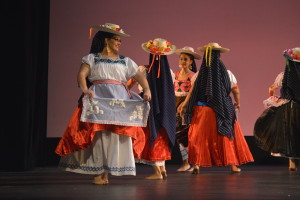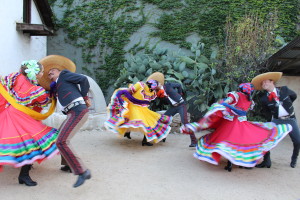LIVING IN THE BAY AREA, we are fortunate to be in one of the most ethnically diverse regions of the United States. Our home is so diverse, that in 2013, Dancers’ Group conducted a “census” of the dance ecosystem, and found well over 800 dance entities in the region. This confirmed that the dance sector in the San Francisco Bay Area is amongst, if not the largest per capita in the country. It’s a hugely diverse sector both in terms of aesthetics as well as organizational structure, form and size.
Within this thriving and diverse dance sector lives one of the largest Mexican folk dance communities in the country ranging from school groups, dance academies, after school programs, semi professional companies and more nationally recognized organizations. In a region where in 2010 the Californian hispanic/latino population of 38.4 % was predicted to grow to 39% in 2014, surpassing the white population, it is no surprise to find that Mexican folk dance groups, or grupos folclóricos, are some of the most public symbols of Mexican cultural heritage. It is here in the Bay Area that I also discovered a passion for this beautiful cultural form that has allowed me to explore my cultural heritage, artistically express myself, and discover a deep passion that has influenced me since I was a young girl.
Today, Mexican folclórico in the Bay Area is rich and plentiful, boasting annual conferences, weekly performances, and multitudes of opportunity to take classes in the form and to learn about its history and significance. With each of México’s 31 states offering its own regional dances and customs, most (if not all) can be experienced somewhere in the Bay. So far this year members of the Bay Area’s folclórico community have announced a national tour, have re-secured folclórico’s place in public schools, have had groups celebrate momentous anniversaries, have gone far back to our roots, and have reflected on our history here in a country far from its birthplace.

An Extremely Brief History of Folclórico
In México, before the arrival of the Spanish, it is known that dance was an integral part of the lives of the indigenous people of México. Most of the dances were religious and considered to be ritualistic or related to seasonal festivals, but many were also secular with no religious or spiritual basis. When the Spanish arrived, new influences made their way into the existing dances and new dance forms were created. Additionally, European ballroom dance also found its way to México, which is historically noted in published instructional guides from the era on how to dance the polka, waltz, shottishe, and more. With these European influences, the Mexican mestizo dances began to develop within their geographical regions.
Later, during the post-Revolutionary period from 1910-1920, the dances began to be gathered and shared outside of their region of origin as the romantic nationalistic movement in México took place, prompting the collecting of dances in an attempt to further define national identity and traditions. Emphasis, though, was placed more on defining the diverse regions within the country through their folk practices in an attempt to capture the culture while also promoting that the Mexican nation still had unique characteristics. Folclórico was used as a way for the various ethnic groups to be labeled within the hegemonic order.
The result of these actions led to a project called Las Misiones Culturales Rurales led by México’s Secretary of Public Education, which focused on reaching out to the indigenous and farmworkers and consequently collecting the dances and teaching them in school in the 1920s, albeit simplified and sometimes lacking context, as those who were teaching the dances often lacked the basics in regards to meaning, context and history of each dance’s region. These attempts, however, led to the recognition of the nation’s cultural diversity as the dances instilled national pride in the students, a sense of community, and boosted creative critical thinking, as art often does. Later came the traveling carpas (a traveling theater of sorts) in the 1920s and 1930s and soon after México saw the birth of one of its first and most well known performing groups, El Ballet Folclórico de México de Amalia Hernandez, which was instrumental in promoting the traditions internationally and prompting the establishing of other performing groups. Many of which paved the path for groups in México and the United States.

Ballet and Baile
Hernandez’ goal was to preserve and promote Mexican culture through music and dance by creating theatrical dance pieces based on the anthropological and historical research that she conducted in towns she visited. By the late 1950s, the dance company had presented a series of folk dance programs for national television, toured globally on behalf of the country/government, and was made the official cultural representative of the Mexican government by the Department of Tourism as well as the national Ballet Company as part of the Instituto Nacional de Bellas Artes (the cultural hub of México). While Hernandez became regarded as a major leader and specialist in Mexican folk dance, Hernandez’ own background in classical European ballet was prominent in her pieces and continues today in her company’s folkloric ballets.
Nonetheless, her approach of traveling to villages and studying their dances and determining what elements to incorporate into her folkloric ballets was controversial. Folkloristas began to wonder how much personal creativity could be applied to the traditional dance forms without removing the context and without warping the original dance. While all groups and their directors offer their own interpretations of the dances to create their public display of Mexican heritage, differences among the groups have shown to depend on where along the two extremes they lie: public/ stage espectaculo or a preservation of the traditional forms. The goal, of course, would be to merge the two extremes and exist in the middle, respecting the past and creating the future. To further call out this separation some groups began specifically avoiding the word ‘ballet’ in the description of their group to remove themselves from the connotations of reflecting the upper class. Out of this emerged ‘grupo folclórico’ as a description that let others know their intent was to present a more traditional version of folclórico with a more modest stylization, sans ballet influence.
These extremes continue to bring up questions in the community in regards to negotiating how to preserve the ‘character of folk.’ As I speak to other folclórico directors and younger dancers there is an agreement and awareness that these complex conversations around teaching and preserving our tradition are happening.
Folclórico in da Bay

Today, folclórico has traveled far from its native México and made its home in various communities around the world—one of the largest being here in the San Francisco Bay Area. With a long history of being in California, and even being taught in public schools as part of the California world folk dance curriculum, the range of folclórico in the community is diverse, vibrant and busy.
For instance, Union City’s Ballet Folklórico de James Logan High School, led by Director Jaime Huertas and Assistant Director Lisa Moreno, celebrated their 25th anniversary in May. Operating like a dance company, the program is part of the school’s afterschool program rehearsing 4-5 days a week. The dancers may be young, but they dance as well as any adult group in the area and can confidently represent the culture. Recently in May the group competed and placed 1st in Mi Pueblo’s Competencia de Baile Folklórico over dozens of the region’s folclórico groups, winning $3,000 to go towards their dance wardrobe.
One of the sponsors of the Mi Pueblo Competencia de Baile Folklórico, Oakland’s professional company of Ballet Folklórico Mexicano de Carlos Moreno, also announced that they are developing two programs to nationally tour—an opportunity that is extremely rare for an American folclórico group. They are working on developing two programs: one that will be a collaboration with Grammy Award winning Los Lobos and the other which Ballet Folklórico Mexicano de Carlos Moreno will present independently.
And in San Jose, Ballet Folklórico Mexicano Fuego Nuevo, founded and led by Jose Luis Juarez y Miguel Angel Martinez from México City, is in the midst of celebrating their 10th anniversary as a company by presenting two large shows in July at the California Theatre in San Jose. With humble beginnings the group has grown to over 100 members and students: “At first the group was just made up of my nieces and nephews. And then as word went around many more came!” Juarez exclaims. For Juarez the experience of growing has been worthwhile; “it’s so satisfying to present something so big, especially coming from a different perspective as a dancer to a leader. But it’s about the kids and them learning and preserving the culture regardless of them being away from their native México. The same passion is still there, even in a different culture.”
Also in the South Bay, Los Lupeños de San José continue to navigate their transition to promote the awareness, appreciation, and understanding of the rich and passionate culture of México through dance under the leadership of their new Artistic Director, award-winning choreographer Samuel Cortez. After a successful fundraising campaign through Silicon Valley Gives, the group is next preparing to participate in Dancers’ Group’s and World Arts West’s Rotunda Dance Series in August.
These Bay Area organizations are only a handful of the active and performing folclórico groups of the region. There are hundreds more navigating the form, teaching and passing on the history and traditions. While this beautiful cultural heritage continues to develop and face its own changes, it will continue to have a beautiful, global future.
This article appeared in the July/August 2015 issue of In Dance.


